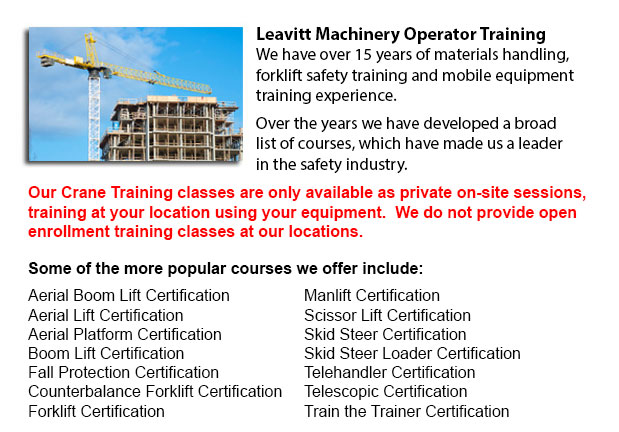
Kelowna Crane Operator Classes - For the supervisors and the operators, current and new, the crane operator training course is suitable for all. Course content addresses relevant provincial, state and federal safety regulations. The first part of training includes comprehensive in-class instruction and exam. Following that is a hands-on customized session with practical instruction and assessment.
The content of the course applies to all types and categories of overhead lifting crane machinery. The instruction would particularly focus on all aspects of crane operation which can be carried out at the trainee's workplace. Upon finishing the course, trainees would know how to operate particular overhead lifting equipment, related parts and attachments efficiently and safely.
The operator course's objective is to first identify and potentially dangerous operator habits which may develop while a person operates an overhead crane. Costly damage to products and equipment can be prevented with proper habits. Training reduces the possibility of a workplace injury or incident occurring.
The course will encompass about eight hours of classroom instruction with a couple of hours of on-site, hands-on, customized training. Participants will be graded on their knowledge of training material via written testing and an assessment of their practical knowledge. The minimum acceptable score is 80%.
The in-class session, the trainee would learn regarding legislation and guidelines, causes of damages and occurrences, internal responsibility, danger awareness, capacity ratings/load weight calculations, basic equipment and design principles, safe hosting/operating methods, pre-shift equipment inspections, types of hardware, equipment applications/rigging, pedestrian/operator safety, hitches and angles, hand signals for operators and slingers, flipping/turning loads safely.
The practical training and evaluation portion of the course should be pre-scheduled. This customized part of the training would be held at the trainees' facility. The length of this practical training component is an hour or two. Two operators at a time would be trained by the instructor on skills like safe operation, planning the lift and right rigging practices.
After finishing both the in-class instruction and the practical training and evaluation, the trainee would be tested via an exam. Every participant will be needed to sign the safety rules. Successful trainees would be provided with individual wallet certificates. A framed wall certificate would be provided to the company.
-
Kelowna Forklift Training Program
Kelowna Forklift Training Program - The lift truck is a common powered industrial vehicle which is in wide use these days. They are sometimes called hi los, lift trucks or jitneys. A departments store would use the forklift to unload and load merchan... More -
Kelowna Crane License
Kelowna Crane License - Crane operators ought to be "credentialed", that means they ought to have a crane operator certification or license. Credentialing is considered a mandatory governmental requirement in order to practice as an operator of a cra... More -
Kelowna Boom Lift Safety Training
Kelowna Boom Lift Safey Training - Boom lifts fall under the type of elevated work platform or aerial lifting device. Most usually used in warehousing, construction and industry; the boom lift is so versatile that it could be utilized in almost whate... More -
Kelowna Loader Training
Kelowna Loader Training - Loader Training - Any individual who would like to operate a forklift should take a Loader Training course in order to become a certified forklift truck operator. There are a variety of ways to obtain forklift training. Cour... More -
Kelowna Aerial Lift Safety Training
Kelowna Aerial Lift Safety Training - Each and every year, there are roughly 26 construction deaths attributed to the use of aerial lifts. Most of the craftsmen killed are electrical workers, laborers, painters, ironworkers or carpenters. The majorit... More -
Kelowna Crane Ticket
Kelowna Crane Ticket - Modern cranes can either be simple or complex, based upon the nature of the application they can carry out. For example, mobile cranes are somewhat simple units. A telescopic boom and even a steel truss mounts its movable platf... More -
Kelowna Boom Lift Operator Training
Kelowna Boom Lift Operator Training - The cherry picker work platform is a type of work platform, that will typically have a bucket or platform at the end of a hydraulic lifting system. The machine is likewise referred to as a man lift, boom lift, hy... More -
Kelowna Heavy Equipment Ticket
Kelowna Heavy Equipment Ticket - Depending on the nature of the job at hand, the kind of construction equipment that a heavy equipment operator makes use of differs. Every kind of machine is made to perform particular tasks in the most effective mann... More

Leavitt Operator Training
TOLL FREE: 1-888-254-6157
101-864 McCurdy Place
Kelowna, British Columbia
forkliftcertificationkelowna.com
Email Us
About Us


